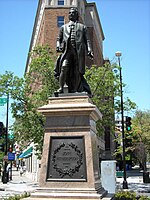Doctor John Witherspoon is a bronze sculpture and granite pedestal which depicts John Witherspoon, a Presbyterian minister, member of Congress, and signer of the Declaration of Independence. Born in Scotland, Witherspoon immigrated to the U.S. in the 1760s and later became president of the College of New Jersey (now known as Princeton University). He strongly supported the Thirteen Colonies in their fight to obtain freedom from the United Kingdom of Great Britain and Ireland.
Witherspoon served in the Second Continental Congress and, after the American Revolutionary War ended, in the U.S. Congress. He was the only reverend who served in Congress at that time. In 1792, Witherspoon lost his eye sight after an infection and died two years later. It wasn't until over 100 years later that plans were made to erect a statue of Witherspoon in Washington, D.C.
Members of the Church of the Covenant (now known as National Presbyterian Church) and other Presbyterians formed the Witherspoon Memorial Association in 1907. After raising enough funds for the memorial, they lobbied members of Congress for permission to erect the memorial on public land. The joint resolution passed in 1908. By that time, sculptor William CouperJ had begun working on the statue. The following year the memorial was dedicated. Prominent attendees at the event included future president Woodrow Wilson, Vice President James S. Sherman, former Secretary of State John W. Foster, and British Ambassador James Bryce, 1st Viscount Bryce.
The memorial is located at the intersection of 18th Street NW, Connecticut Avenue, and N Street NW, in the Dupont Circle neighborhood. The statue is bronze and depicts Witherspoon holding a Bible. On one of the memorial's pedestal is a quote from Witherspoon. When the Church of the Covenant was razed in 1966, church members wanted the statue moved to its new location, but the government denied their request. The memorial is one of 14 American Revolution Statuary collectively listed on the National Register of Historic Places and the District of Columbia Inventory of Historic Sites. The memorial is also a contributing property to the Dupont Circle Historic District and the L'Enfant Plan.








